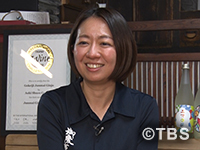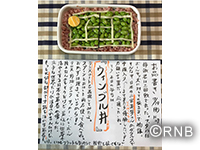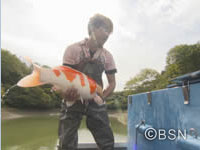Documentary
![]()
The Unsung Experts of Japan | Japan in Focus | Discover Asia | Japan’s Unsung Masters - Live! | NINJA | BOSAI: Be Prepared |
A Young Woman’s Challenge: Born a Sake Brewer’s Daughter
DC282079![]()
JNNドキュメンタリーザ・フォーカス 青二才の挑戦~蔵元の娘に生まれて~ [TBS]
![]()
![]()

|Length : 25min |Year : 2020 |
Chisa Aoki left her job as a nurse to return to her family-run sake brewery. At the time, she knew nearly nothing about sake. Soon after her return, however, the brewery's signature brand began garnering prestigious awards both in Japan and abroad.
In 2018, Chisa embarked on a new challenge: "Nisai no Kamoshi" is a brand whose production is entrusted to a brewer in their twenties. This season will be Chisa's last as the brewer of "Nisai no Kamoshi."
Chisa reaches out to create a team of young men and women who will join her in every step of the sake-making process to create a version of the brand uniquely their own. Our cameras are there to follow the entire sake-making process and the warm relationships between Chisa and her family, the brewers and the customers who love sake.
From Dad to Daughter : The 700th Bento Box
DC282078![]()
パパとなっちゃんのお弁当 [RNB]
![]()
![]()

|Length : 26min |Year : 2020 |
Taisuke Aono lives in Niihama, Ehime Prefecture.
All he knew how to cook was burnt chicken and yakisoba filled with vegetables. But when his daughter Nat-chan started high school, he decided to start making bento boxes for her.
Nat-chan didn't think he could keep this up for long, since he couldn't stick to a diet, or quit drinking and smoking. And the first bento box he made was a mess...
But her dad kept cooking in the kitchen morning after morning.
All of his bento boxes came with a handwritten menu.
He would give each bento box a title, like "Wimbledon" or "Motivational Katsudon Bento," and would write about Nat-chan's club activities, her tests, events happening in Japan, and updates about his diets.
For three years, he kept making bento boxes and writing menus.
These menus soon became letters from father to daughter.
It wasn't long before he'd made 100, then 500, then nearly 700 lunch boxes. Then came Nat-chan's graduation.
What did he write for his 700th and final menu?
This program depicts the casual life of a single-parent family, and one father's loving bento boxes with humorous and emotional menus.
The People Brought Together by“BENTO”
DC281975![]()
由美子ちゃんのお弁当 [RNB]
![]()
![]()

|Length : 45 |Year : 2019 |
On the coast of an inlet in western Ehime Prefecture is the town of Tawarazu. This small community with a population of 1,000 has many elderly residents.
This town has a bento box shop called “Yumesakuya,” run by the 55-year-old Yumiko Utsunomiya. She also delivers meals, to help senior citizens who can’t shop for themselves.
Koume, one of her elderly customers, says to Yumiko, “I’m as helpless as a baby. Don’t leave me alone, please.”
Yumiko’s bento bring the lonely senior citizens comfort, and save their lives.
What is it that drives Yumiko?
“Putting a smile on people’s faces.”
As Japan’s population ages, more and more senior citizens have no means to feed themselves. Tawarazu, which used to prosper from mandarin orange orchards, is no exception.
At “Yumesakuya,” the town’s mothers work hard to save these shopping refugees.
They deliver to the elderly who can’t walk to the store out of a spirit of charity. What would be a ten minute’s walk for a healthy person is impossibly far away for others.
After the heavy rains of July 2018, “Yumesakuya” reopened as a mini-supermarket.
This documentary portrays the plight of shopping refugees, and the powerful lives of the local mothers who stand up for them.
Kyoto’s Unique Elementary School System ~Determining the Future for Children〜
DC281973![]()
番組小学校150年 ~明治の情熱、今に~
![]()
![]()

|Length : 28 |Year : 2019 |
A way before the government started Elementary School administrative system, Kyoto’s towns people established 64 elementary schools, one in each district and total of 64 schools in Kyoto city after the Meiji Restoration in 1869.
This episode introduces how these schools were established and why as well as how their roles changed over the years.
Living with Carp ~Beautiful Lives Nurtured ㏌ The Mountain Village~
DC281972![]()
コイビト 山里に育む美しき生命 [BSN]
![]()
![]()

|Length : 47 |Year : 2019 |
The Yamakoshi District, in Nagaoka, Niigata Prefecture, is the site of over 1600 mud ponds, where Nishikigoi originate. Out of hundreds of thousands of fry the most promising in color and form are selected to swim for a few years in these mud ponds, in the midst of nature, to grow into large beauties. In the autumn, people from around the world gather in Yamakoshi. The popularity of Nishikigoi outside of Japan was triggered by a certain Englishman. What is it that he finds fascinating about Nishikigoi? Learn about the thoughts of the growers who carry on the traditions of their forebears, and about their passion to create superior koi.















